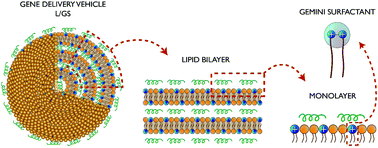Kelvin probe force microscopy to study electrostatic interactions of DNA with lipid–gemini surfactant monolayers for gene delivery†
Abstract
In novel gene therapy mechanisms utilising gemini surfactants, electrostatic interactions of the surfactant molecules with the DNA strands is a primary mechanism by which the two components of the delivery vehicle bind. In this work, we show for the first time direct evidence of electrostatic interactions of these compounds visualised with Kelvin probe force microscopy (KPFM) and correlated to their topography from atomic force microscopy (AFM). We construct monolayers of lipids and gemini surfactant to simulate interactions on a cellular level, using lipids commonly found in cell membranes, and allow DNA to bind to the monolayer as it is formed on a Langmuir–Blodgett trough. The difference in topography and electrical surface potential between monolayers with and without DNA is striking. In fact, KPFM reveals a strongly positive relative electrical surface potential in between where we identify a background lipid and the DNA strands, evidenced by the height profiles of the domains. Such identification is not possible without KPFM. We conclude that it is likely we are seeing cationic surfactant molecules surrounding DNA strands within a sea of background lipid.



 Please wait while we load your content...
Please wait while we load your content...